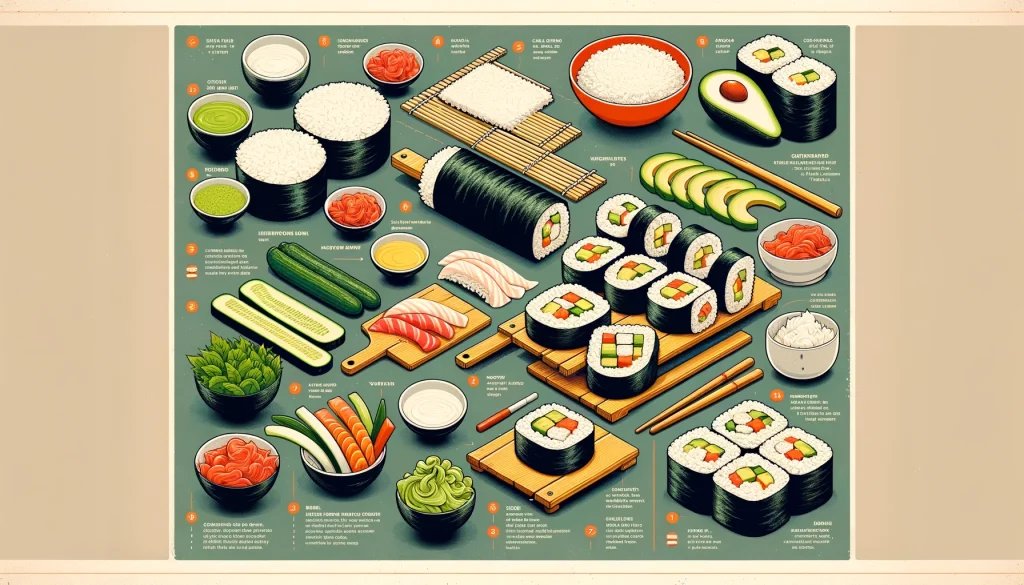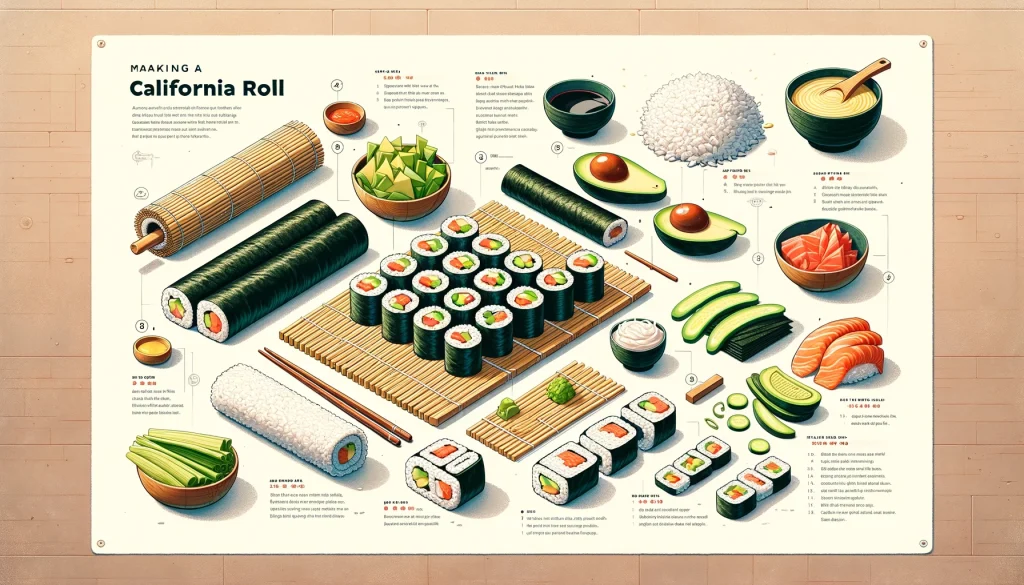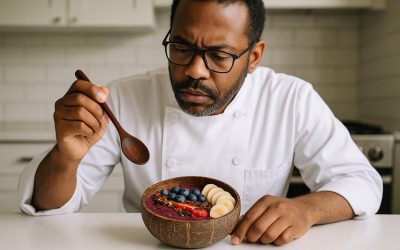As an Amazon Associate I earn from qualifying purchases.
The California roll, a quintessential staple of American sushi cuisine, stands as a hallmark of culinary fusion and innovation. This delightful creation, characterized by its inside-out rice layer enveloped around cucumber, avocado, and imitation crab, has captivated the palates of food enthusiasts far beyond its origins. Its invention is a testament to the adaptability and creativity of chefs who sought to cater to Western tastes by reimagining traditional Japanese sushi. The result is a dish that not only serves as an accessible introduction to the flavors of sushi for newcomers but also retains a beloved spot on the menu for seasoned aficionados.
This article aims to unravel the layers of the California roll, from its intriguing history and cultural significance to the meticulous craft behind its preparation. By providing a step-by-step guide, expert tips for perfecting the recipe at home, and insights into the variations that have emerged, we invite both novice cooks and experienced gourmands to explore the depths of this iconic roll. Whether you’re a sushi purist or someone who delights in the fusion of flavors, the California roll offers a fascinating glimpse into the world of culinary creativity, blending the delicate balance of textures and tastes with the artistry of sushi making. Join us as we delve into the art and allure of crafting the perfect California roll, a dish that continues to evolve while remaining true to its roots as a bridge between cultures.
California Roll Recipe

Making a California roll at home is a fun and rewarding experience. This popular sushi roll is great for those who prefer non-raw options. Here’s a simple recipe to make California rolls:
Ingredients:
Sushi Rice:
- 2 cups sushi or short-grain rice
- 2 ½ cups water
- ½ cup rice vinegar
- 2 tablespoons sugar
- 1 teaspoon salt
Roll Fillings:
- 1 cucumber, peeled, seeded, and cut into thin strips
- 1 avocado, peeled, pitted, and sliced into thin strips
- 4 sheets nori (seaweed)
- 8 ounces imitation crab meat, shredded
- Sesame seeds (optional)
For Serving:
- Soy sauce
- Pickled ginger
- Wasabi
Equipment:
- Bamboo sushi mat
- Plastic wrap
Instructions:
1. Prepare the Sushi Rice:
- Rinse the rice under cold water until the water runs clear. Combine rice and water in a rice cooker and cook according to the manufacturer’s instructions.
- While the rice cooks, heat the rice vinegar, sugar, and salt in a small pan over medium heat until the sugar dissolves. Cool to room temperature.
- Transfer the cooked rice to a large bowl and gently fold in the vinegar mixture. Spread the rice on a plate or a tray and allow it to cool to room temperature, covered with a damp cloth.
2. Prepare the Fillings:
- Prepare the cucumber, avocado, and imitation crab meat. Set aside.
3. Assemble the Rolls:
- Place a sheet of nori on a bamboo sushi mat covered with plastic wrap.
- Wet your hands with water and vinegar solution to prevent sticking, then spread a thin layer of rice over the nori, leaving about an inch of space at the top.
- Sprinkle sesame seeds over the rice if desired.
- Place a row of cucumber, avocado, and imitation crab along the bottom edge of the rice-covered nori.
- Begin rolling the nori tightly from the bottom, using the mat to help form a tight roll. Once rolled, use the mat to gently squeeze and shape the roll.
- Remove the roll from the mat and cut into 6-8 pieces with a sharp, wet knife for clean slices.
4. Serve:
- Arrange the California rolls on a plate with pickled ginger, wasabi, and soy sauce for dipping.
Enjoy your homemade California rolls as a delicious appetizer, snack, or part of a sushi feast!
Expert Tips
Creating the perfect California roll is an art that combines taste, technique, and presentation. Here are expert tips to elevate your California roll recipe and impress anyone with your sushi-making skills:
1. Rice is Key:
- The quality of your sushi starts with the rice. Use a specific sushi or short-grain rice for the best texture. The rice should be sticky but not mushy, holding its shape without being hard.
2. Seasoning the Rice:
- The seasoning mix of rice vinegar, sugar, and salt is crucial. Adjust the balance according to your taste, but remember that the rice should have a subtle tang to complement the fillings. Ensure the seasoning is evenly distributed for consistent flavor.
3. Preparing the Ingredients:
- Cut the cucumber, avocado, and imitation crab into long, thin strips to ensure each piece of sushi has a balanced mix of flavors and textures.
- Sprinkle lemon juice over the avocado slices to prevent them from browning.
4. Nori Placement:
- For a California roll, the rice goes on the outside. Place the nori shiny side down on your bamboo mat to ensure the rice covers the rough side, which helps it stick better.
5. Rolling Technique:
- Use a bamboo mat covered with plastic wrap to prevent sticking. When rolling, apply even pressure to create a tight roll. Don’t squeeze too hard, or you’ll crush the ingredients.
6. Cutting the Rolls:
- Use a sharp, wet knife to cut the rolls. Wetting the knife prevents the rice from sticking and ensures clean cuts. Clean the knife after each cut for the best presentation.
7. Presentation:
- Presentation is part of the sushi experience. Arrange the slices neatly on a plate, garnished with pickled ginger and wasabi. Consider adding a sprinkle of sesame seeds or tobiko (flying fish roe) for an extra touch of elegance and flavor.
8. Serving Temperature:
- Sushi tastes best when the rice is at room temperature, and the fillings are slightly chilled. This contrast enhances the flavors and makes for a more enjoyable eating experience.
9. Pairing with Soy Sauce:
- When serving, offer soy sauce for dipping, but advise guests to dip lightly. The sushi should be flavored well enough that it only needs a touch of soy sauce, without overpowering the delicate flavors of the fillings.
10. Practice Makes Perfect:
- Sushi rolling is a skill that improves with practice. Don’t be discouraged if your first few rolls aren’t perfect. Keep practicing, and you’ll quickly get the hang of it.
By following these expert tips, you’ll be well on your way to making California rolls that rival those of your favorite sushi restaurant. Enjoy the process and the delicious results of your labor!
Why This Recipe Is Just So Good…
The California roll, with its harmonious blend of creamy avocado, crisp cucumber, and sweet, tender imitation crab wrapped in seasoned sushi rice and seaweed, stands out as a culinary masterpiece that has captivated the taste buds of sushi lovers worldwide. Here’s why this recipe is just so good:
1. Accessible Ingredients:
- The California roll is celebrated for its use of readily available ingredients that are both simple and flavorful. Unlike traditional sushi that requires fresh fish, the ingredients for a California roll can be found in most supermarkets, making it an accessible option for sushi enthusiasts everywhere.
2. Perfect Balance of Flavors:
- This recipe achieves a perfect balance of flavors and textures. The creamy avocado, crunchy cucumber, and sweet imitation crab, combined with the tangy seasoned rice, create a delightful symphony of tastes. The subtle use of sesame seeds or tobiko adds an extra layer of texture and flavor, enhancing the overall dining experience.
3. Versatility:
- The California roll serves as a versatile base for experimentation. Chefs and home cooks alike can tweak the recipe to include their favorite ingredients, such as spicy mayo, different types of vegetables, or even real crab meat, allowing for endless variations that cater to individual preferences.
4. Appeal to Sushi Beginners:
- For those new to sushi, the California roll provides a gentle introduction. Its use of cooked ingredients addresses common reservations about consuming raw fish, making it a gateway to exploring more traditional sushi offerings.
5. Aesthetic Presentation:
- The visual appeal of the California roll, with its contrasting colors and textures, makes it not just a meal but a work of art. The outer layer of rice, speckled with sesame seeds or tobiko, encases the vibrant green avocado and pinkish hue of the crab, creating a dish that is as pleasing to the eye as it is to the palate.
6. Culinary Innovation:
- The California roll is a testament to culinary innovation. Its inside-out structure, with rice on the outside, was a groundbreaking twist when it first appeared. This innovative approach not only solved the problem of nori’s unfamiliarity to Western palates but also opened the door to new possibilities in sushi-making.
7. Nutritional Value:
- This recipe offers a mix of nutritional benefits, including healthy fats from avocado, carbohydrates from sushi rice, and protein from imitation crab. It’s a satisfying meal that provides energy without being overly heavy, making it suitable for a variety of dietary preferences.
8. Cultural Fusion:
- The California roll is a prime example of cultural fusion, blending traditional Japanese sushi techniques with ingredients popular in the American palate. This fusion has led to a broader acceptance and appreciation of Japanese cuisine, marking the California roll as a culinary ambassador.
In conclusion, the California roll recipe’s enduring popularity lies in its delightful combination of flavors, textures, and colors, its accessibility, and its role in introducing sushi to a global audience. It’s a dish that embodies simplicity and sophistication, making it a beloved classic in the world of sushi.
Storage Instructions
Storing California rolls properly is essential to maintain their freshness and flavor, especially considering they contain ingredients like avocado that can brown or spoil quickly. Here’s how to store your homemade California rolls:
Short-term Storage:
- Refrigeration: If you plan to eat the California rolls within 24 hours, you can store them in the refrigerator. Place them in an airtight container to prevent them from absorbing smells from other foods and to keep the rice from drying out.
- Plastic Wrap: Tightly wrap each roll in plastic wrap before placing it in the container. This helps to keep the rolls moist and fresh.
- Serving Next Day: If serving the rolls the next day, consider waiting to cut them until just before serving to preserve freshness.
Avoiding Avocado Browning:
- Lemon Juice: Brushing a bit of lemon juice on the slices of avocado before rolling can help prevent browning.
- Tight Wrapping: Ensuring the rolls are wrapped tightly with plastic wrap also limits air exposure, reducing browning.
Freezing California Rolls:
- Not Recommended: Freezing California rolls is generally not recommended, especially because of the avocado and the texture of the rice. Freezing can significantly alter the texture, making the rice hard and the avocado mushy upon thawing.
Tips for Best Quality:
- Eat Fresh: California rolls are best enjoyed fresh, ideally within a few hours of making them. The fresher, the better, as the texture and flavor of the ingredients are at their peak.
- Temperature Matters: Keep stored California rolls chilled but not too cold, as extreme cold can also affect the rice’s texture, making it hard and less enjoyable. The ideal refrigerator temperature is around 37°F (3°C).
Serving After Storage:
- Gentle Room Temperature Transition: If you’ve stored the rolls in the fridge, let them sit at room temperature for about 10 to 20 minutes before serving. This slight tempering can improve the texture of the rice, making it softer and more palatable.
- Check Before Eating: Always inspect the rolls for any signs of spoilage, especially if they’ve been stored for a bit. If the avocado has browned slightly but the rolls still smell and look fresh, they should be fine to eat. However, if there’s any off odor or other signs of spoilage, it’s best to discard them.
By following these storage instructions, you can enjoy your homemade California rolls with minimal loss in quality, ensuring a delicious sushi experience even after some time has passed since preparation.
Frequently Asked Questions (FAQ)

Q: What is the best rice to use for making California rolls?
A: The best rice for making California rolls is sushi rice, which is a type of short-grain rice known for its sticky and moist texture when cooked. This stickiness is crucial for the rice to hold together the roll’s ingredients. Look for labels that say “sushi rice” or use Japanese short-grain rice varieties like Koshihikari or Calrose.
Q: How can I prevent my avocado from browning in the California roll?
A: To prevent avocado from browning, you can brush it with lemon juice or lime juice immediately after cutting. The citric acid in the juice acts as an antioxidant, slowing down the oxidation process that leads to browning. Additionally, keeping the rolls tightly wrapped until serving time minimizes air exposure, further preventing browning.
Q: Can I make California rolls without a bamboo mat?
A: Yes, you can make California rolls without a bamboo mat, although the mat helps in achieving a tight and even roll. If you don’t have a mat, you can use a piece of parchment paper or a clean kitchen towel as a substitute. Lay the nori on the parchment paper or towel, add your ingredients, and use the paper or towel to roll it tightly, applying even pressure.
Q: Is it necessary to use raw or cooked crab meat for California rolls?
A: Traditional California rolls use imitation crab meat, which is cooked and processed seafood made from surimi (a fish paste). However, you can also use real crab meat if you prefer; ensure it’s cooked and shredded or chopped into small pieces. Whether you choose imitation or real crab, both options do not require raw seafood, making California rolls a great choice for those cautious about consuming raw fish.
Q: How do I achieve the perfect sushi rice texture?
A: Achieving the perfect sushi rice texture involves rinsing the rice thoroughly until the water runs clear to remove excess starch. Cook the rice according to package instructions or use a rice cooker. Once cooked, gently fold in a seasoned mix of rice vinegar, sugar, and salt while the rice is still warm. Spread the rice out on a tray or a wide bowl to cool to room temperature, covering it with a damp cloth to prevent drying. The key is to handle the rice gently to maintain its integrity while ensuring it’s seasoned well and sticky enough for sushi making.
Q: How long can I store California rolls before they go bad?
A: California rolls are best enjoyed fresh but can be stored in the refrigerator for up to 24 hours. Beyond that, the rice may become hard, and the avocado may start to brown and lose its fresh texture and flavor. If you must store them, wrap tightly in plastic wrap and keep them in an airtight container in the fridge. Always check for freshness before consuming stored sushi.
Q: What are some creative variations of the California roll?
A: Creative variations of the California roll can include adding or substituting ingredients for a unique twist. Try incorporating cream cheese for a creamy texture, using smoked salmon instead of imitation crab for a different flavor profile, or adding thinly sliced mango or strawberries for a sweet contrast. Spicy mayonnaise or sriracha can add a kick, and toppings like tobiko (flying fish roe) or sesame seeds can offer an extra crunch and visual appeal.
By considering these expert answers, you can enhance your California roll-making experience, ensuring delicious results that cater to a wide range of tastes and preferences.
Conclusion
The California roll, with its unique inside-out appearance and harmonious blend of avocado, cucumber, and imitation crab, has not only established itself as a cornerstone of American sushi culture but also as a symbol of culinary fusion that transcends traditional boundaries. This iconic roll serves as a bridge, introducing many to the intricate world of sushi and demonstrating the possibilities that arise from blending different culinary traditions. Its creation marks a pivotal moment in the globalization of sushi, transforming it from a niche to a global phenomenon beloved by many.
Through the exploration of the California roll recipe, from its basic components to the artistry involved in its assembly, we’ve seen how something seemingly simple can encapsulate a rich tapestry of flavors and textures. The roll’s enduring popularity underscores the universal appeal of food that combines familiarity with novelty, making the exotic accessible and the traditional new again.
For those who embark on the journey of making a California roll at home, the process is more than just a culinary endeavor; it’s an invitation to partake in a global culinary dialogue that celebrates innovation, adaptation, and the sheer joy of sharing good food. Whether enjoyed in a bustling sushi bar or from the comfort of one’s kitchen, the California roll remains a testament to the power of food to bring people together, to innovate within tradition, and to delight with every bite.
As we conclude this exploration of the California roll, let it be a reminder of the endless possibilities that await in the world of cooking and the ways in which food can connect us to different cultures, histories, and each other. The California roll is not just a recipe to be followed; it’s a story of culinary evolution, a dish that continues to evolve and inspire, inviting each of us to roll up our sleeves and add our own chapter to its ongoing story.






